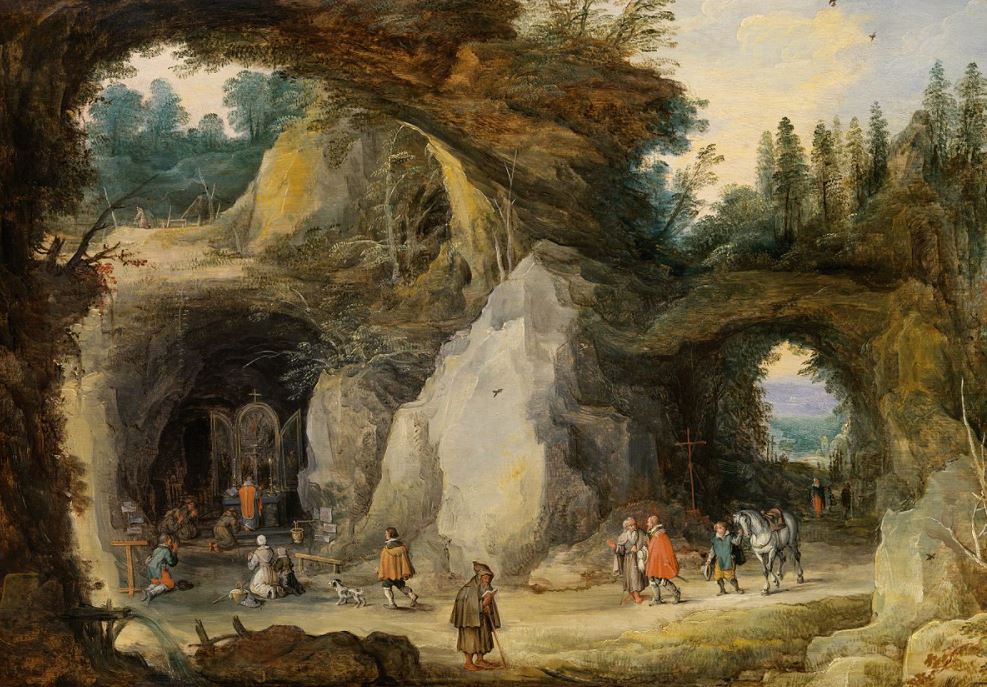The son of a famous Renaissance painter named Pieter Bruegel the Elder (1525-1569) became one of the most talented painters in history himself, albeit predominantly in a style referred to as Mannerism or “Late-Renaissance.”
Jan Brueghel the Elder (1568-1625) was a close friend of Peter Paul Rubens and both men are considered the leading Flemish painters of their time in the early 17th century.
In this article, we’ll check out some of the most famous Jan Brueghel the Elder paintings so you can understand why he is considered to be one of the most renowned Mannerist artists in history.
1. Mountain Landscape with Pilgrims in a Grotto Chapel
- Date Created: Between 1610 and 1626
- Dimensions: 56 × 80 centimeters (22 × 31.4 inches)
- Location: Liechtenstein Museum, Vienna, Austria
Mountain Landscape with Pilgrims in a Grotto Chapel is also sometimes referred to as “A Hermit before a Grotto” is a painting in which the artist collaborated with one of his colleagues named Joos de Momper (1564-1635).
It’s uncertain when this painting was completed but some art historians date it to 1616. It’s one of the many paintings featuring a grotto that defined this era in painting. Most of the figures depicted in this painting were completed by Jan Brueghel the Elder.

2. The Senses of Hearing, Touch, and Taste
- Date Created: 1620
- Dimensions: 176 x 264 centimeters (69.29 x 103.93 inches)
- Location: Museo del Prado, Madrid, Spain
The Senses of Hearing, Touch, and Taste is a huge painting and an allegorical depiction of figures who represent the senses. We can see children singing (hearing), a young woman petting a mink (touch), and another woman reaching out for oysters on the table (taste). Brueghel also collaborated with Rubens on “The Five Senses,” a series of 5 paintings with the same subject.
What’s remarkable about this complex work is that the paintings hanging on the wall also represent the senses. We can see “The Annunciation” and “Minerva´s Visit to Parnassus” (hearing), “The Dentist” (touch), and “The Punishment of Rich Epulon” and “The Wedding at Cana” (taste).

3. The Entry of the Animals into Noah’s Ark
- Date Created: 1613
- Dimensions: 54.6 × 83.8 centimeters (21.5 × 33 inches)
- Location: The Getty Museum, Los Angeles, United States
The Entry of the Animals into Noah’s Ark is one of the most popular subjects in art history and displays a wide range of wild animals that are ready to get on board Noah’s Ark. These range from huge elephants to small turtles, as well as a wide range of exotic birds.
Jan Brueghel painted this work while he was employed as a court painter by the Spanish rulers of the Southern Netherlands called Archduke Albert and the Infanta Isabella. The use of exotic animals really arrived with the conquest of the Americas and this painting is a prime example of this.

4. Monkeys Feasting
- Date Created: 1621
- Dimensions: 27 x 36 centimeters (10.62 x 14.17 inches)
- Location: Private collection, on loan to the Rubenshuis in Antwerp
The animals depicted in “The Entry of the Animals into Noah’s Ark” weren’t the only time that the artist depicted exotic creatures. he also helped the development of a particular type of genre painting called a “Singerie” or “Monkey Scene.”
In this type of painting, monkeys can be seen in a human environment while doing their thing. One of the most famous Jan Brueghel the older paintings is a painting of “Monkeys Feasting,” a remarkable depiction of a large number of monkeys going mental in a house.

5. Excursion in the Countryside of Infanta Isabel Clara Eugenia
- Date Created: Early 17th century (exact date unknown)
- Dimensions: 176 × 238 centimeters (69.3 × 93.7 inches)
- Location: Museo del Prado, Madrid, Spain
Excursion in the Countryside of Infanta Isabel Clara Eugenia is another collaboration between the artist with Joos de Momper. The latter reportedly painted the landscape while Jan Brueghel painted the figures.
This painting depicts an outing of Archduchess Isabel Clara Eugenia in the fields near her summer residence in Mariemont. This former royal estate is located near modern-day Brussels and the immense palace, which was destroyed by fire in 1794, can be seen in the background.

6. The Archdukes Albert and Isabella Visiting a Collector’s Cabinet
- Date Created: 1621-1623
- Dimensions: 94 × 123.3 centimeters (37 × 48.5 inches)
- Location: The Walters Art Museum, Baltimore, United States
The Archdukes Albert and Isabella Visiting a Collector’s Cabinet depict the two rulers of the Southern Netherlands as they visit the art collection of an unknown collector (the man wearing black clothes behind the couple).
The Spanish rulers were considered to be patrons of the art and most probably often visited places like this. It’s unsure where and if this event took place. The painting was a collaboration between Jan Brueghel the Elder and Hieronymus Francken II (1578-1623), another famous Flemish painter at the time.



